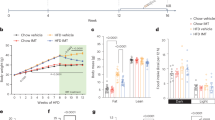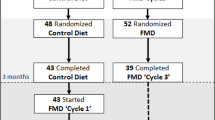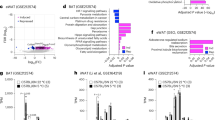Abstract
Uncoupling protein 1 (UCP1) plays a central role in nonshivering thermogenesis in brown fat; however, its role in beige fat remains unclear. Here we report a robust UCP1-independent thermogenic mechanism in beige fat that involves enhanced ATP-dependent Ca2+ cycling by sarco/endoplasmic reticulum Ca2+-ATPase 2b (SERCA2b) and ryanodine receptor 2 (RyR2). Inhibition of SERCA2b impairs UCP1-independent beige fat thermogenesis in humans and mice as well as in pigs, a species that lacks a functional UCP1 protein. Conversely, enhanced Ca2+ cycling by activation of α1- and/or β3-adrenergic receptors or the SERCA2b–RyR2 pathway stimulates UCP1-independent thermogenesis in beige adipocytes. In the absence of UCP1, beige fat dynamically expends glucose through enhanced glycolysis, tricarboxylic acid metabolism and pyruvate dehydrogenase activity for ATP-dependent thermogenesis through the SERCA2b pathway; beige fat thereby functions as a 'glucose sink' and improves glucose tolerance independently of body weight loss. Our study uncovers a noncanonical thermogenic mechanism through which beige fat controls whole-body energy homeostasis via Ca2+ cycling.
This is a preview of subscription content, access via your institution
Access options
Access Nature and 54 other Nature Portfolio journals
Get Nature+, our best-value online-access subscription
$29.99 / 30 days
cancel any time
Subscribe to this journal
Receive 12 print issues and online access
$209.00 per year
only $17.42 per issue
Buy this article
- Purchase on Springer Link
- Instant access to full article PDF
Prices may be subject to local taxes which are calculated during checkout






Similar content being viewed by others
Accession codes
References
Golozoubova, V. et al. Only UCP1 can mediate adaptive nonshivering thermogenesis in the cold. FASEB J. 15, 2048–2050 (2001).
Nedergaard, J. et al. UCP1: the only protein able to mediate adaptive non-shivering thermogenesis and metabolic inefficiency. Biochim. Biophys. Acta 1504, 82–106 (2001).
Kajimura, S., Spiegelman, B.M. & Seale, P. Brown and beige fat: physiological roles beyond heat generation. Cell Metab. 22, 546–559 (2015).
Wu, J. et al. Beige adipocytes are a distinct type of thermogenic fat cell in mouse and human. Cell 150, 366–376 (2012).
Shabalina, I.G. et al. UCP1 in brite/beige adipose tissue mitochondria is functionally thermogenic. Cell Rep. 5, 1196–1203 (2013).
Okamatsu-Ogura, Y. et al. Thermogenic ability of uncoupling protein 1 in beige adipocytes in mice. PLoS One 8, e84229 (2013).
Cinti, S. The Adipose Organ (Editrice Kurtis, 1999).
Petrovic, N. et al. Chronic peroxisome proliferator-activated receptor γ (PPARγ) activation of epididymally derived white adipocyte cultures reveals a population of thermogenically competent, UCP1-containing adipocytes molecularly distinct from classic brown adipocytes. J. Biol. Chem. 285, 7153–7164 (2010).
Nedergaard, J. & Cannon, B. UCP1 mRNA does not produce heat. Biochim. Biophys. Acta 1831, 943–949 (2013).
Xue, B. et al. Genetic variability affects the development of brown adipocytes in white fat but not in interscapular brown fat. J. Lipid Res. 48, 41–51 (2007).
Guerra, C., Koza, R.A., Yamashita, H., Walsh, K. & Kozak, L.P. Emergence of brown adipocytes in white fat in mice is under genetic control. Effects on body weight and adiposity. J. Clin. Invest. 102, 412–420 (1998).
Seale, P. et al. Prdm16 determines the thermogenic program of subcutaneous white adipose tissue in mice. J. Clin. Invest. 121, 96–105 (2011).
Shinoda, K. et al. Phosphoproteomics identifies CK2 as a negative regulator of beige adipocyte thermogenesis and energy expenditure. Cell Metab. 22, 997–1008 (2015).
McDonald, M.E. et al. Myocardin-related transcription factor A regulates conversion of progenitors to beige adipocytes. Cell 160, 105–118 (2015).
Vegiopoulos, A. et al. Cyclooxygenase-2 controls energy homeostasis in mice by de novo recruitment of brown adipocytes. Science 328, 1158–1161 (2010).
Cohen, P. et al. Ablation of PRDM16 and beige adipose causes metabolic dysfunction and a subcutaneous to visceral fat switch. Cell 156, 304–316 (2014).
Ohno, H., Shinoda, K., Ohyama, K., Sharp, L.Z. & Kajimura, S. EHMT1 controls brown adipose cell fate and thermogenesis through the PRDM16 complex. Nature 504, 163–167 (2013).
Ukropec, J., Anunciado, R.P., Ravussin, Y., Hulver, M.W. & Kozak, L.P. UCP1-independent thermogenesis in white adipose tissue of cold-acclimated Ucp1−/− mice. J. Biol. Chem. 281, 31894–31908 (2006).
Granneman, J.G., Burnazi, M., Zhu, Z. & Schwamb, L.A. White adipose tissue contributes to UCP1-independent thermogenesis. Am. J. Physiol. Endocrinol. Metab. 285, E1230–E1236 (2003).
Rowland, L.A., Bal, N.C., Kozak, L.P. & Periasamy, M. Uncoupling protein 1 and sarcolipin are required to maintain optimal thermogenesis, and loss of both systems compromises survival of mice under cold stress. J. Biol. Chem. 290, 12282–12289 (2015).
Bal, N.C. et al. Sarcolipin is a newly identified regulator of muscle-based thermogenesis in mammals. Nat. Med. 18, 1575–1579 (2012).
Kazak, L. et al. A creatine-driven substrate cycle enhances energy expenditure and thermogenesis in beige fat. Cell 163, 643–655 (2015).
Enerbäck, S. et al. Mice lacking mitochondrial uncoupling protein are cold-sensitive but not obese. Nature 387, 90–94 (1997).
Tripathi, S. et al. Meta- and orthogonal integration of influenza “OMICs” data defines a role for UBR4 in virus budding. Cell Host Microbe 18, 723–735 (2015).
Fujii, J. et al. Identification of a mutation in porcine ryanodine receptor associated with malignant hyperthermia. Science 253, 448–451 (1991).
Quane, K.A. et al. Mutations in the ryanodine receptor gene in central core disease and malignant hyperthermia. Nat. Genet. 5, 51–55 (1993).
Shinoda, K. et al. Genetic and functional characterization of clonally derived adult human brown adipocytes. Nat. Med. 21, 389–394 (2015).
Collins, S. β-adrenoceptor signaling networks in adipocytes for recruiting stored fat and energy expenditure. Front. Endocrinol. (Lausanne) 2, 102 (2012).
Fedorenko, A., Lishko, P.V. & Kirichok, Y. Mechanism of fatty-acid-dependent UCP1 uncoupling in brown fat mitochondria. Cell 151, 400–413 (2012).
Bertholet, A.M. et al. Mitochondrial patch clamp of beige adipocytes reveals UCP1-positive and UCP1-negative cells both exhibiting futile creatine cycling. Cell Metab. 25, 811–822 (2017).
Lee, S.C., Nuccitelli, R. & Pappone, P.A. Adrenergically activated Ca2+ increases in brown fat cells: effects of Ca2+, K+, and K channel block. Am. J. Physiol. 264, C217–C228 (1993).
Prestle, J. et al. Overexpression of FK506-binding protein FKBP12.6 in cardiomyocytes reduces ryanodine receptor–mediated Ca2+ leak from the sarcoplasmic reticulum and increases contractility. Circ. Res. 88, 188–194 (2001).
Gómez, A.M. et al. FKBP12.6 overexpression decreases Ca2+ spark amplitude but enhances [Ca2+]i transient in rat cardiac myocytes. Am. J. Physiol. Heart Circ. Physiol. 287, H1987–H1993 (2004).
Loughrey, C.M. et al. Over-expression of FK506-binding protein FKBP12.6 alters excitation–contraction coupling in adult rabbit cardiomyocytes. J. Physiol. (Lond.) 556, 919–934 (2004).
Wehrens, X.H. et al. Protection from cardiac arrhythmia through ryanodine receptor–stabilizing protein calstabin2. Science 304, 292–296 (2004).
Santulli, G. et al. Calcium release channel RyR2 regulates insulin release and glucose homeostasis. J. Clin. Invest. 125, 1968–1978 (2015).
Berg, F., Gustafson, U. & Andersson, L. The uncoupling protein 1 gene (UCP1) is disrupted in the pig lineage: a genetic explanation for poor thermoregulation in piglets. PLoS Genet. 2, e129 (2006).
Denton, R.M. Regulation of mitochondrial dehydrogenases by calcium ions. Biochim. Biophys. Acta 1787, 1309–1316 (2009).
Marx, S.O. et al. PKA phosphorylation dissociates FKBP12.6 from the calcium release channel (ryanodine receptor): defective regulation in failing hearts. Cell 101, 365–376 (2000).
Kramarova, T.V. et al. Mitochondrial ATP synthase levels in brown adipose tissue are governed by the c-Fo subunit P1 isoform. FASEB J. 22, 55–63 (2008).
Block, B.A. Thermogenesis in muscle. Annu. Rev. Physiol. 56, 535–577 (1994).
Fu, S. et al. Aberrant lipid metabolism disrupts calcium homeostasis causing liver endoplasmic reticulum stress in obesity. Nature 473, 528–531 (2011).
Park, S.W., Zhou, Y., Lee, J., Lee, J. & Ozcan, U. Sarco(endo)plasmic reticulum Ca2+-ATPase 2b is a major regulator of endoplasmic reticulum stress and glucose homeostasis in obesity. Proc. Natl. Acad. Sci. USA 107, 19320–19325 (2010).
Tubbs, E. et al. Mitochondria-associated endoplasmic reticulum membrane (MAM) integrity is required for insulin signaling and is implicated in hepatic insulin resistance. Diabetes 63, 3279–3294 (2014).
Arruda, A.P. et al. Chronic enrichment of hepatic endoplasmic reticulum–mitochondria contact leads to mitochondrial dysfunction in obesity. Nat. Med. 20, 1427–1435 (2014).
Yoneshiro, T. et al. Age-related decrease in cold-activated brown adipose tissue and accumulation of body fat in healthy humans. Obesity (Silver Spring) 19, 1755–1760 (2011).
Saito, M. et al. High incidence of metabolically active brown adipose tissue in healthy adult humans: effects of cold exposure and adiposity. Diabetes 58, 1526–1531 (2009).
Tiso, N. et al. Identification of mutations in the cardiac ryanodine receptor gene in families affected with arrhythmogenic right ventricular cardiomyopathy type 2 (ARVD2). Hum. Mol. Genet. 10, 189–194 (2001).
Marks, A.R., Priori, S., Memmi, M., Kontula, K. & Laitinen, P.J. Involvement of the cardiac ryanodine receptor/calcium release channel in catecholaminergic polymorphic ventricular tachycardia. J. Cell. Physiol. 190, 1–6 (2002).
Seale, P. et al. Transcriptional control of brown fat determination by PRDM16. Cell Metab. 6, 38–54 (2007).
Feketa, V.V., Balasubramanian, A., Flores, C.M., Player, M.R. & Marrelli, S.P. Shivering and tachycardic responses to external cooling in mice are substantially suppressed by TRPV1 activation but not by TRPM8 inhibition. Am. J. Physiol. Regul. Integr. Comp. Physiol. 305, R1040–R1050 (2013).
Soga, T. et al. Differential metabolomics reveals ophthalmic acid as an oxidative stress biomarker indicating hepatic glutathione consumption. J. Biol. Chem. 281, 16768–16776 (2006).
Soga, T. et al. Metabolomic profiling of anionic metabolites by capillary electrophoresis mass spectrometry. Anal. Chem. 81, 6165–6174 (2009).
Soga, T. & Heiger, D.N. Amino acid analysis by capillary electrophoresis electrospray ionization mass spectrometry. Anal. Chem. 72, 1236–1241 (2000).
Acknowledgements
We thank W. Chen at the University of Calgary for providing the RyR2 overexpression construct. We are also grateful to C. Paillart for his support in the CLAMS studies, Y. Seo for his support in [18F]FDG uptake assays, R. Zalpuri for technical assistance in electron microscope analysis, K. Nakamura for his advice in tissue temperature recording, and B.M. Spiegelman, E.T. Chouchani and L. Kazak for their feedback. This work was supported by the National Institutes of Health (DK97441 and DK108822), the Pew Charitable Trust and Japan Science and Technology Agency to S.K., and by Agency for Medical Research and Development–Core research for Revolutionary Science and Technology (AMED–CREST) from the Japan Agency for Medical Research and Development, CREST from the Japan Science and Technology Agency, and research funds from the Yamagata prefectural government and the city of Tsuruoka to T.S. We also acknowledge support from the University of California San Francisco (UCSF) Diabetes Endocrinology Research Center (DERC) (DK63720), the Yale University Mouse Metabolic Phenotyping Center (MMPC) (U2CDK059635) and DK40936. K.I. and K.T. are supported by the Manpei Suzuki Diabetes Foundation. Q.K. is supported by the China Scholarship Council (201506350063). T.Y. is supported by Grant-in-Aid for Scientific Research from the Ministry of Education, Culture, Sports, Science and Technology of Japan (2610103). K.S. is supported by National Institutes of Health K99 grant (DK110426). X.L. is supported by China Postdoctoral Council (2014M551176).
Author information
Authors and Affiliations
Contributions
K.I. and S.K. conceived the study and designed experiments. K.I., Q.K., T.Y., Y.C., X. L., P.M., K.T. and S.K. performed experiments. J.P.C. performed mouse metabolic studies. H.M., M.H. and T.S. performed metabolomics. K.S. performed bioinformatics analyses. K.M.A. contributed pig cell line generation. K.I., Q.K., T.Y., J.P.C., T.S. and S.K. analyzed and interpreted the data. K.I. and S.K. wrote the manuscript. K.I., P.M. and S.K. edited the manuscript.
Corresponding author
Ethics declarations
Competing interests
The authors declare no competing financial interests.
Supplementary information
Supplementary Figures & Table
Supplementary Figures 1–12 & Supplementary Table 2 (PDF 14105 kb)
Life Sciences Reporting Summary
Life Sciences Reporting Summary (PDF 172 kb)
Supplementary Table 1
Metabolomics dataset of inguinal WAT (XLSX 94 kb)
Rights and permissions
About this article
Cite this article
Ikeda, K., Kang, Q., Yoneshiro, T. et al. UCP1-independent signaling involving SERCA2b-mediated calcium cycling regulates beige fat thermogenesis and systemic glucose homeostasis. Nat Med 23, 1454–1465 (2017). https://doi.org/10.1038/nm.4429
Received:
Accepted:
Published:
Issue Date:
DOI: https://doi.org/10.1038/nm.4429
This article is cited by
-
Deep learning enables the quantification of browning capacity of human adipose samples
Journal of Big Data (2024)
-
Glucocorticoids increase adiposity by stimulating Krüppel-like factor 9 expression in macrophages
Nature Communications (2024)
-
Futile lipid cycling: from biochemistry to physiology
Nature Metabolism (2024)
-
Brown adipose tissue CoQ deficiency activates the integrated stress response and FGF21-dependent mitohormesis
The EMBO Journal (2024)
-
Pulling the trigger: Noncoding RNAs in white adipose tissue browning
Reviews in Endocrine and Metabolic Disorders (2024)



